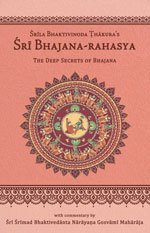Bhajana-Rahasya
by Srila Bhaktivinoda Thakura Mahasaya | 2010 | 123,965 words
The Bhajana-rahasya Text 4, English translation, including commentary (vritti). The Bhajana-rahasya is a compilation of verses describing the mercy of the eight pairs of names (Yugala-nama) of the Maha-mantra. This is text 4 belonging to the chapter “Shashtha-yama-sadhana (Sayam-kaliya-bhajana–bhava)” representing six dandas after dusk: approximately 6.00 p.m.–8.30 p.m.
Text 4
The anubhāvas that arise in a devotee when he reaches a developed stage of bhāva are listed in Bhakti-rasāmṛta-sindhu (2.2.2):
नृत्यं विलुठितं गीतं क्रोशनं तनु-मोटनम्
हुङ्कारो जृम्भणं श्वास-भूमा लोकानपेक्षिता
लालास्रावो’ट्ट-हासश् च घूर्णा-हिक्कादयो’पि चnṛtyaṃ viluṭhitaṃ gītaṃ krośanaṃ tanu-moṭanam
huṅkāro jṛmbhaṇaṃ śvāsa-bhūmā lokānapekṣitā
lālāsrāvo’ṭṭa-hāsaś ca ghūrṇā-hikkādayo’pi caThe external transformations that reveal the heart’s emotions (bhāvas) are called anubhāvas. They are dancing (nṛtya), rolling on the ground (viluṭhita), singing (gīta), loud crying (krośana), writhing of the body (tanu-moṭana), roaring (huṅkāra), yawning (jṛmbhaṇa ), breathing heavily (śvāsa-bhūmā), neglecting others (lokānapekṣitā), drooling (lālāsrāva ), loud laughter (aṭṭa-hāsa), staggering about (ghūrṇā ) and hiccups (hikkā).
नृत्य, गडागडि, गीत, चीत्कार, हुङ्कार
तनु-फोले, हाङी उठे, श्वास बार बारnṛtya, gaḍāgaḍi, gīta, cītkāra, huṅkāra
tanu-phole, hāṅī uṭhe, śvāsa bāra bāraलोकापेक्षा छाडे, लालास्राव, अट्टहास
हिक्का घूर्णा बाह्य अनुभाव सुप्रकाशlokāpekṣā chāḍe, lālāsrāva, aṭṭahāsa
hikkā ghūrṇā bāhya anubhāva suprakāśa
Commentary: Bhajana-rahasya-vṛtti:
With the development of the sādhaka’s transcendental emotions, the above-mentioned anubhāvas manifest. Not caring for public opinion, the sādhaka chants and dances. It is impossible for worldly-minded persons to understand such activities of the devotees. The behaviour of the devotees who can taste bhāva (bhāvuka bhaktas) is completely different from that of mundane persons. Sometimes, hypocrites, who desire material gain, worship or fame, imitate the activities of pure devotees. Once, while watching a snake dance, nāmācārya Śrīla Haridāsa Ṭhākura remembered Śrī Kṛṣṇa’s pastime of subduing Kāliya-nāga (kāliyadamana-līlā ) and started to dance. Other devotees took his foot-dust and smeared it on their heads, considering themselves very fortunate. An envious brāhmaṇa began to imitate Haridāsa Ṭhākura, but no devotee was attracted to him, and instead he was scolded by the snake-charmer.
